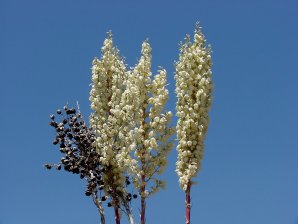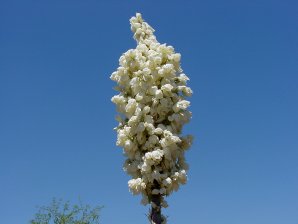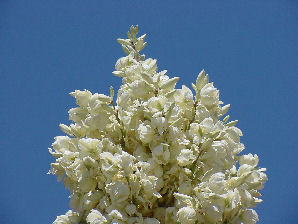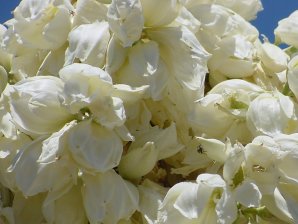Arizona Wild Flowers
Pictures, Photos, Images
Descriptions, Information, Reviews.
Soaptree Yucca, Yucca elata.
We Are Proud Of Our SafeSurf Rating!
Click On Any Of The Following Links By Amazon.Com
For Books, & Videos About Wildflowers Of Arizona & The Southwest USA. No Obligation!
 |
| Soaptree Yucca, Yucca elata. Photo Taken June 13, 2003 Near Hillside, Arizona. |
|---|
 |  |
| Soaptree Yucca, Yucca elata. | Soaptree Yucca, Yucca elata. |
|---|---|
 |  |
| Leaves Used For Basketweaving. | White Blossoms. |
 /
/

Soaptree Yucca.
We wish to thank Wikipedia, the free encyclopedia for some of the information on this page. We share images and information with Wikipedia. Yucca elata is an evergreen erect, trunk-forming succulent, which also forms branches. Only one flower emerges from each branch clump per season. If more than one stalk is present, the others were left over from prior years. Soaptree yucca produces from seed and by sprouting. The leaves were used for basket making by Native Arizonans, the flowers are edible, and the roots can be used for soap. Soaptree Yucca (as well as other yuccas) rely on the female Pronuba Moth for pollination. No other pollinator can transfer the pollen from one flower to another. The female Yucca Moth has evolved special organs which collect and distribute the pollen onto the surface of the flower. The moth then lays her eggs in the flowers' ovaries, and when the larvae hatch, they feed upon the yucca seeds. Without this moth, the Soaptree Yucca could not reproduce, nor could the moth, whose larvae need the seeds to eat. An old Soaptree Yucca can sprout new plants from its roots, however only the seeds produced by pollinated flowers can scatter far enough away from the old plant to establish a new stand of plants.
Yucca elata was in the Aguave or Agave Family but now is in the Lilly Family.
Quick Notes:
Height: 6 feet To About 20 feet tall. Normal branch spread about 6 feet. Some about 12 feet spread are known of.
Flowers: They form on a stalk emerging from the central portion of each branch, they grow 4' - 6' above the foliage, with a loose spike of hanging white, bell-shaped flowers; they bloom in the spring. They are followed by a 3-chambered brown pod about 2" - 3" long and about 1 1/2" - 2" across; containing small seed.
Flowering Time: March - April.
Trunk: Up To About 1 1/2 Foot Thick. A single trunk with arm-like branches and old dry leaves left in place.
Leaves: Long slender blades, to 4ft long, 1/2in wide, flexible when green, sharp tips; develops white threads along margins. The old leaves turn yellow to cream color and bend downward, forming a barrier around the trunk.
Found: Native to the southwestern United States; in the Sonoran Desert and Chihuahuan Desert in the states of (AZ, NM, NV, TX, & UT); and to northern Mexico in (Chihuahua, Coahuila, Sonora, & Nuevo Le�n).
Hardiness:
Soil pH requirements:
Sun Exposure:
Elevation: 0 - 6,000 Feet.
Habitat: Hillsides And Rocky Plains in Arizona with coarse soils derived from igneous materials.
Miscellaneous: Flowering Photos Taken June 13, 2003 Near Hillside, Arizona.
|
We Are Proud Of Our SafeSurf Rating!



We Are Proud Of Our SafeSurf Rating!
Click On Any Of The Following Links By Amazon.Com
For Books, & Videos About Xerioscape Plants Of Arizona & The Southwest USA. No Obligation!
Back To Arizona Wild Flowers Home Page.
Back To Arizona Wild Flowers, Cream - White Flowers Page One.
Back To Arizona Xeriscape Landscaping Main Page.
Back To Xeriscape Succulents Page One.
Back To DeLange Home Page
© 1966 - Present, Audrey, Eve, & George DeLange
| © 1966 - Present, Audrey, Eve, & George DeLange |


